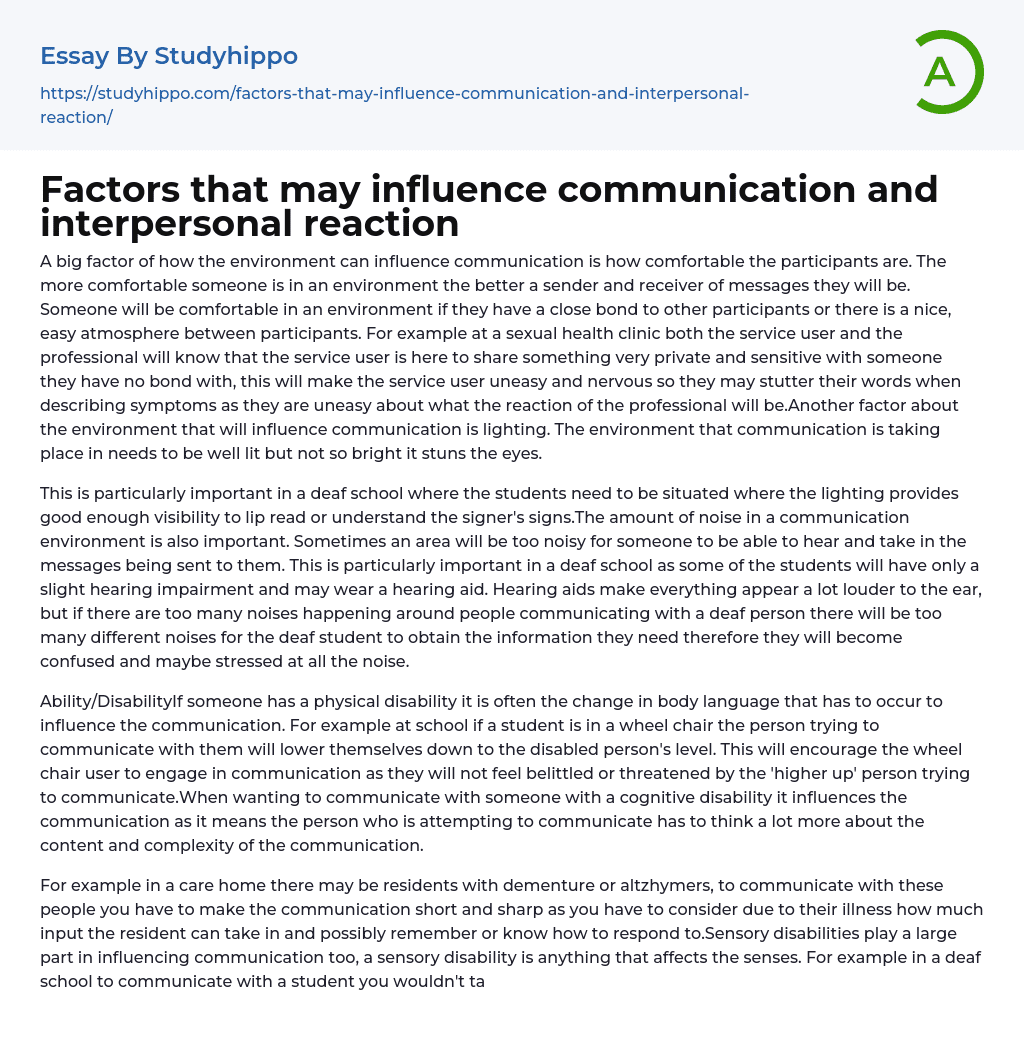

Factors that may influence communication and interpersonal reaction Essay Example
The level of comfort among participants is a significant factor that affects communication in various environments. When individuals feel comfortable, they are more effective as both senders and receivers of messages. Comfort may arise from close relationships between participants or a relaxed atmosphere. For instance, in a sexual health clinic, the service user and the professional may lack any bond, causing the former to feel unsettled and anxious when sharing private and sensitive information. This discomfort can manifest in speech difficulties, such as stuttering, as the service user worries about the professional's reaction. The environment's lighting is another aspect that influences communication.
In a school for the deaf, it is important to have appropriate lighting that allows for lip reading and understanding of sign language without being too bright. The level of noise is also crucial as excessive noise can make it d
...ifficult for students with slight hearing impairments who wear hearing aids to hear and understand messages. While hearing aids amplify sound, an environment with multiple noises can be confusing and stressful for deaf students, making it challenging for them to gather the information they need.
When interacting with individuals who have physical disabilities, the way we communicate often necessitates adjusting our body language. For instance, if a student in a wheelchair is present at school, the communicator will lower themselves to the wheelchair user's level. This approach promotes inclusive communication and prevents the disabled individual from feeling marginalized or intimidated by someone in a higher position.
Similarly, when engaging with individuals who have cognitive disabilities, it profoundly affects our communication style. It requires us to carefully consider the content and complexity of our messages. In care
homes where residents may suffer from dementia or Alzheimer's disease, concise and straightforward communication becomes crucial. Due to their condition, we must assess how much information they can process and whether they possess the ability to remember or respond effectively.
Sensory disabilities also play a significant role in shaping communication methods. A sensory disability pertains to any impairment that impacts an individual's senses.
Communication in a deaf school necessitates employing diverse methods to interact with students who have hearing impairments. Culture plays a crucial role as individuals come from various backgrounds, religions, ethnicities, social classes, genders, and ages. These factors can limit communication in terms of both style and content. For instance, if a social services case involves a Muslim woman, she may adhere to her religious beliefs and refrain from direct interaction with male professionals since her religion allows contact only with her spouse.
A Muslim woman at a hospital may decline treatment from a man due to religious beliefs that forbid physical contact with any man other than her husband or male family members. Stereotypes can have positive or negative associations and are often based on specific traits associated with individuals. For instance, in a care home, a resident might perceive someone with tattoos, piercings, and a crew cut hairstyle as a "punk" who takes advantage of vulnerable people. As a result, if the resident is assigned such a carer, she will immediately request another one without giving the current carer an opportunity. This preconceived notion impedes the potential for meaningful connection between the resident and the carer, regardless of their abilities. People who hold biased views typically avoid interacting with individuals who conform to their
preconceived prejudices.
Attitudes are important in communication, as demonstrated in a hospital setting where discrimination based on race can create barriers. Negative attitudes towards quitting smoking and meeting new people may cause individuals to avoid support groups, resulting in missed opportunities for learning and practicing communication skills. Additionally, the content of messages impacts their effectiveness, requiring careful consideration from senders. Sensitivity is crucial when informing families about a patient's death in the operating room; nurses often use comforting gestures and deliver the news gently. Emotion and personality also affect communication, with low self-esteem hindering interaction in situations like adoption homes where some children believe they are unapproachable.Furthermore, individuals with unpredictable behavior can be intimidating to others, causing them to feel reluctant when it comes to conversing. This fear stems from the concern of being unable to connect or having uncomfortable interactions with such individuals.
- Greeting essays
- Orality essays
- Intercultural Communication essays
- Interpersonal Communication essays
- Cross-Cultural Communication essays
- Nonverbal Communication essays
- Effective Communication essays
- Communication Skills essays
- Multiculturalism essays
- Cultural Diversity essays
- Diversity essays
- Peer Pressure essays
- Oppression essays
- Racial Profiling essays
- Discrimination essays
- Ageism essays
- Sexism essays
- Gender Discrimination essays
- Caregiver essays
- Arranged Marriage essays
- Communication essays
- Conflict Management essays
- Conflict Resolution essays
- Connection essays
- Conversation essays
- Dating essays
- Friendship essays
- Mediation essays
- Abortion essays
- Abuse essays
- Animal Rights essays
- Animal Testing essays
- Assault essays
- Bullying essays
- Controversial Issue essays
- Crash essays
- Cyber Bullying essays
- Feminism essays
- Human Rights essays
- Immigration essays
- Inequality essays
- Poverty essays
- Prejudice essays
- Racism essays
- Torture essays
- Violence essays
- Anthropology essays
- Audience essays
- Charity essays
- Cultural Competence essays



